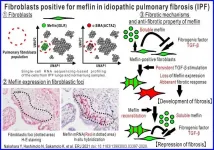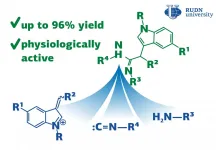(Press-News.org) Fukuoka, Japan--At this very moment, the billions of neurons in your brain are using their trillions of connections to enable you to read and comprehend this sentence.
Now, by studying the neurons involved in the sense of smell, researchers from Kyushu University's Faculty of Medical Sciences report a new mechanism behind the biomolecular bonsai that selectively strengthens these connections.
How neuronal circuits remodel themselves over time, especially during early development, is an open question in neurobiology. At the start of neuronal development, neurons form excessive amounts of connections that are gradually eliminated as others are strengthened.
Studying a type of olfactory neuron known as a mitral cell in mice, the research team found that the protein BMPR-2 is one of the key regulators of selective stabilization of neuron branching and that the strengthening only happens when the branch receives signals from other neurons.
"A main reason we use olfactory neurons is because they are easy to access and study, and mitral cells develop only a single branch," explains Shuhei Aihara, first author of the study published in Cell Reports.
"When an olfactory neuron detects a specific molecule that we smell, it sends the signal to a specific 'way station' in the brain's olfactory bulb called a glomerulus. That signal is then relayed to the brain through mitral cells. One mitral cell receives signals for one specific smell."
At a very early stage in development, these mitral cells send branches into many glomeruli. As time progresses, these branches--known as dendrites--are pruned away to leave only a single, strong connection. The research team set out to uncover what kind of molecular cues caused one branch to be favored over others.
After analyzing candidate factors known to control dendritic growth and remodeling from extrinsic signals, the team focused on the protein BMPR-2.
"When we disrupted BMPR-2, mitral cells would fail in the selective stabilization and form multiple connections to multiple glomeruli," explains Aihara. "In our next step, we found that BMPR-2 is bound to a protein called LIMK, and only when BMPR-2 is activated by the cell-signaling protein called BMP does it release LIMK into the cell."
LIMK is known to activate the process to assemble actin, the cell's 'skeleton.' Once activated, actin begins to build long fibers that stabilize dendrites.
However, this still did not explain how this mechanism strengthens specific dendrites. The team's next step was to find the elements that activate LIMK. Their investigation led them to identify a well-known neurotransmitter, glutamic acid, as one of the factors that kicks off the process.
"Glutamic acid is required for signals to be transmitted between neurons. Taken together, this means that both BMP and neural signals are necessary to form actin, thereby inducing the construction of a stable dendrite," states Aihara.
"It's like the brake and accelerator in your car. You need to release the brake, in this case BMPR-2 releasing LIMK, and then press on the accelerator--the neurotransmitter signal--for your machinery to move forward. The necessity of simultaneous control, or inputs, is the basis of selective branch stabilization."
Takeshi Imai, who led the team, concludes, "Hopefully these new insights into neural development can lead to further understanding of the fundamental mechanisms behind critical brain functions and possible treatments into pathologies underlined by synaptic dysfunction."
"Our next step is to find the factors that promote dendrite pruning, and we also want to see if this mechanism in the olfactory bulb is fundamental throughout the neocortex."
INFORMATION:
For more information about this research, see "BMPR-2 gates activity-dependent stabilization of primary dendrites during mitral cell remodeling" Shuhei Aihara, Satoshi Fujimoto, Richi Sakaguchi, and Takeshi Imai, Cell Reports (2021).
https://doi.org/10.1016/j.celrep.2021.109276
About Kyushu University
Kyushu University is one of Japan's leading research-oriented institutes of higher education since its founding in 1911. Home to around 19,000 students and 8,000 faculty and staff, Kyushu U's world-class research centers cover a wide range of study areas and research fields, from the humanities and arts to engineering and medical sciences. Its multiple campuses--including the largest in Japan--are located around Fukuoka City, a coastal metropolis on the southwestern Japanese island of Kyushu that is frequently ranked among the world's most livable cities and historically known as a gateway to Asia.
The cryosphere, a term used to describe the areas of the Earth's surface where water exists in solid form, plays an important role in regulating the Earth's climate. Due to cryospheric retreat; for example, the melting Greenland ice sheet in the Arctic, greenhouse gases that were formerly in "frozen storage" are now being released. High Mountain Asia, also known as the Tibetan Plateau, hosts the largest volume of glaciers outside the polar regions. However, Tibetan glaciers are currently excluded from global greenhouse gas budgets.
According to Shichang Kang, leader of a group of researchers who recently became the first team to measure the flux variations of greenhouse gases (CO2 and CH4) in typical glacial basins in High Mountain Asia, it's important that Tibetan glaciers are not ...
New research will help doctors identify, treat and prevent potentially dangerous irregular heartbeats in patients with hypertrophic cardiomyopathy (HCM), a common heart condition in which the heart thickens and strains to pump blood.
These chaotic heart rhythms are known as atrial fibrillation. Atrial fibrillation can be asymptomatic, but it can lead to blood clots, stroke or even heart failure. The new research, from an international team of doctors and scientists, identifies risk factors for major atrial fibrillation outcomes, such as the need for procedures or hospitalization for more than 24 ...
Scientists have developed a rapid, highly accurate test to detect antibodies against the spike protein of SARS-CoV-2 in human serum, opening a new avenue for understanding the full extent of the pandemic and evaluating the effectiveness of vaccines.
In the 18 months since the emergence of Covid-19 pandemic, great strides have been made in discovering and inventing various approaches to track and control the spread of the SARS-CoV-2 virus. Rapid and accurate diagnosis has always been vital in this regard. The gold standard since the beginning of the pandemic has been the RT-PCR method; however, it is time-consuming, labor-intensive, and requires sophisticated ...
Single-cell RNA sequencing has revealed a subset of cells that could provide protection from a rare, but severely debilitating and fatal, lung disease. The findings were published by Nagoya University researchers and colleagues in the European Respiratory Journal. Further research could lead to new therapeutic strategies for the disease, called idiopathic pulmonary fibrosis (IPF).
Approximately 15 in every 100,000 people worldwide develop IPF. Its prognosis and five-year survival rate can be worse than many types of cancer. It involves the development of scar tissue on the lung, impairing gas exchange and making ...
Austin, Texas (July 15, 2021)
Access to high-quality public transportation can make communities more equitable by increasing access to critical opportunities such as employment, health care and healthy food, particularly for low-income individuals and people of color. A END ...
INDIANAPOLIS -- Nursing homes throughout the United States have been devastated by the COVID-19 pandemic with many perceptions and misperceptions but little documentation about what has happened on a day-by -day basis to residents in these facilities. A study from Regenstrief Institute and Indiana University School of Medicine research scientists is one of the first to describe and identify patterns in the course of COVID-19 in the typically frail individuals who reside in nursing homes.
Much has been written about number of deaths, vaccine uptake and ...
Bone density, skin and hair health, and the mobility of joints depend to a great extent on the microelement of silicon. We mostly get it with food, but silicon is also consumed with some biologically active additives that promise beauty, longevity, and youth. The element can also be found in drinking water of a natural origin: usually, it is included in the compound of sodium salt and metasiliconic acid. However, in the case of microelements, one should be extremely careful: a deficiency could lead to diseases, but an overdose could bring negative effects too.
Together with colleagues from the Chuvash State University and the Hamburg Medical University, scientists of Immanuel Kant Baltic Federal University studied the effect of prolonged silicon consumption in relatively ...
To date, there are no effective antidotes against most virus infections. An interdisciplinary research team at the Technical University of Munich (TUM) has now developed a new approach: they engulf and neutralize viruses with nano-capsules tailored from genetic material using the DNA origami method. The strategy has already been tested against hepatitis and adeno-associated viruses in cell cultures. It may also prove successful against corona viruses.
There are antibiotics against dangerous bacteria, but few antidotes to treat acute viral infections. Some infections can be prevented by vaccination but developing new vaccines is a long and laborious process.
Now an interdisciplinary research team from the Technical University of Munich, the Helmholtz Zentrum München and ...
A new study finds that resilience is a dynamic process, rather than a fixed trait - and suggests this may have significant ramifications for the business world.
"Organizations are interested in cultivating a resilient workforce, because they want people who are able to remain committed to an organization and its goals over time," says Patrick Flynn, corresponding author of the study and an assistant professor of human resources management at North Carolina State University's Poole College of Management.
"Our work here does a couple things," Flynn says. "First it finds that resilience is more of a process than a characteristic. Second, it identifies some of the ...
RUDN University chemists obtained a metal-containing complex with an unusual planar architecture. The unexpected structure was formed due to the spontaneous fixation of carbon dioxide from the air during the reaction. This compound exhibits unusual magnetic properties (spin glass behaviour). This can be useful for creating memory storage devices. The results are published in the Journal of Organometallic Chemistry
Coordination polymers are hybrid crystalline coordination compounds contained of infinitely repeating fragments (structural elements). These structural ...






